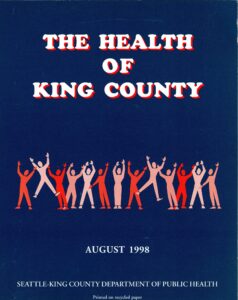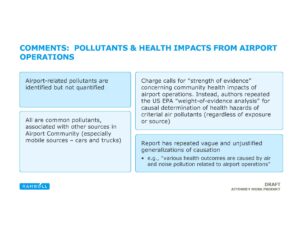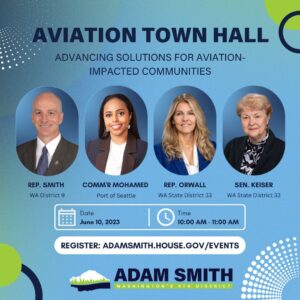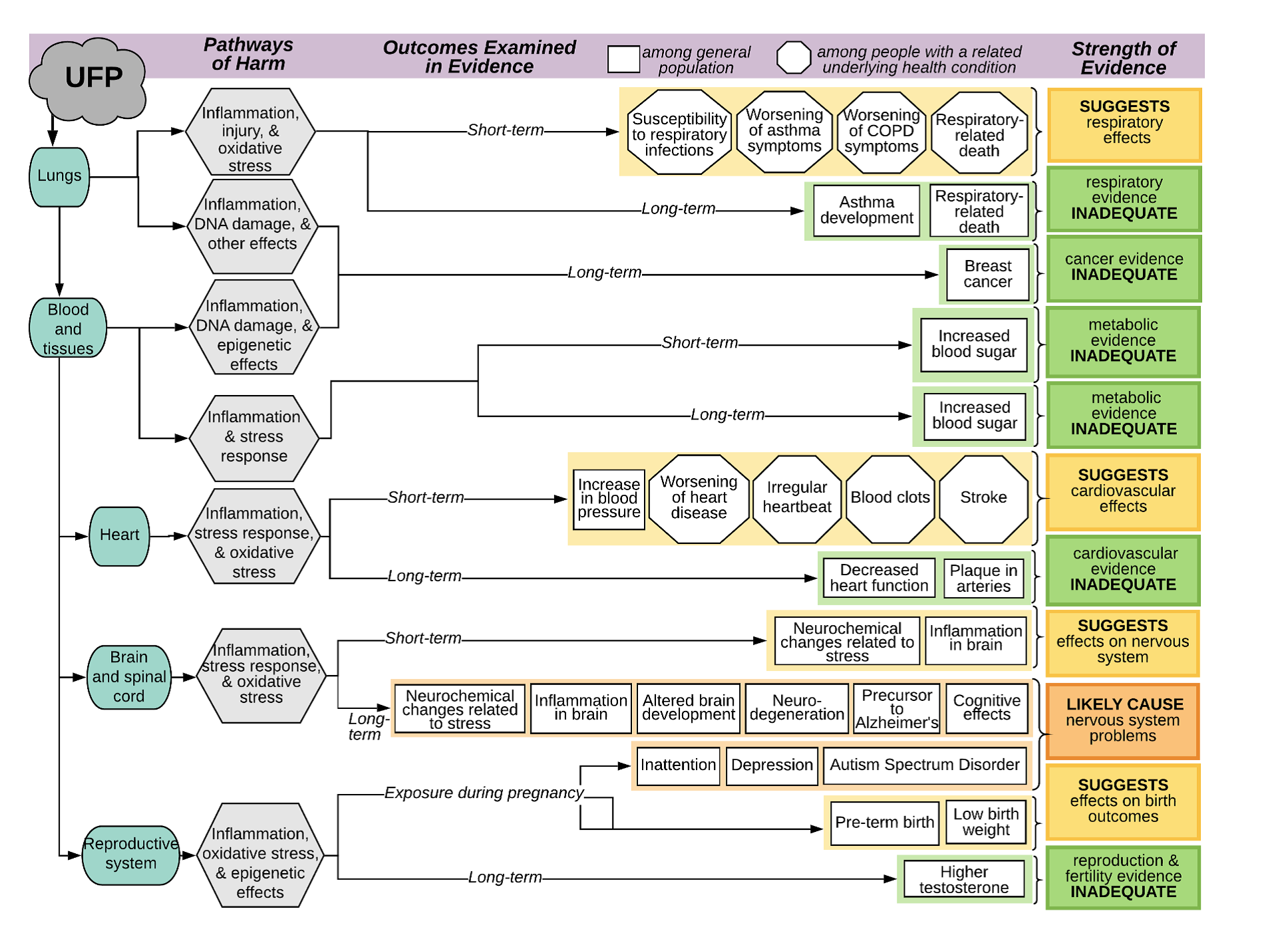The following is a list of suggestions STNI has made to Seattle/King County Department of Health in response to their Community Health and Airport Operations Related Pollution Report , which we’ll refer to as ‘the SKCDOH Report’. The last half of the article describes the political context of these research requests.
Asks
- We would like to know if there is a way to study the indoor air quality of homes with Port Packages. Specifically, those with 1poor Port Packages. We can imagine a combination of “natural experiments”, using existing data (number of homes that received mold remediation eg.) as well as in-home monitoring. But here are some things we think would be valuable to know:
- What is the indoor air quality of homes with Port Packages vs. homes without Port Packages? Since those with and without are literally next door to one another under the current flight path, this should not be hard to survey.
- Is there a way to track the health outcomes between the ‘haves’ and ‘have not’ cohorts?
- Is there a way to track the air quality and/or health of “new and improved” (post Third Runway) Port Packages versus the older/poor systems.
We think ‘c’ matters because the build quality of newer systems seems so much better. Though the Port may have many reasons for not acknowledging prior defects, the new installs speak for themselves. The Port clearly learned some lessons. In short, we also have an opportunity to learn: does sealing up one’s house in a manner sufficient to reduce noise, in itself, create various health impacts that can only be mitigated with additional interventions? And we should know what those are before we start adding new homes (as everyone would like to do, of course.)
- We’d also like to know how to nail down the efficacy of both sound insulation and air purifiers on a ‘part of the day’ basis. Both in homes and in public buildings such as schools. The biggest push back we’ve heard from residents and electeds and school officials against various mitigations is, “If I can’t BBQ on my deck, what’s no point?” It is difficult to overstate the number of people (including various electeds) who believe this–and how strongly held is that belief. Many people–even those with the deepest concerns over the noise-and emissions–are convinced that unless they have 24/7/365 ‘protection’ from the noise and emissions, it will make little difference either to their health or to that of children. In short, doing anything besides “making the planes go somewhere else” (or moving) is either perceived as:
- Optical. It’s nice to show concern, but no one really thinks it matters all that much.
- So pointless that we (government) should not even waste time and resources on it.
The Politics of Research
 Both the State and Seattle/King County DOH have published a series of health overviews going back as far as the 1970’s and the 3Sea-Tac Communities Plan.
Both the State and Seattle/King County DOH have published a series of health overviews going back as far as the 1970’s and the 3Sea-Tac Communities Plan.Here is a summary flyer DOH mailed out in 1998 as part of the full report.
Traditionally the Port has used these reports to make several major arguments against doing anything locally.
The biggest push back we’ve heard from residents and electeds and school officials against various mitigations is, “If I can’t BBQ on my deck, what’s no point?”- The area population has always skewed older/sicker/poorer/less-well-educated. In their view, it is not merely unfair, but simply inaccurate to try correlating airport operations with any of that stuff.
- Aviation emissions make up an almost trivial amount of the overall global impacts to climate and pollution. If there are pollution-correlated negative health outcomes they are far more to do with the fact that the airport is at the nexus of a complex multi-modal transportation system (roads).
- There may have been studies done at other airports, they they may be tantalizing, but those are not Sea-Tac Airport, and thus we’re comparing apples and oranges.
- Except when they are. If the results are inconclusive, regardless of any differences in physics or sociology, those points will tend to be emphasized by the Port–as they would by any corporate enterprise defending its market.
Each of the above are highly cherry pick the facts to
Ramboll Report
 After the release of the SKCDOH Report, the Port of Seattle hired an environmental consultancy to prepare a short summary and critique.
After the release of the SKCDOH Report, the Port of Seattle hired an environmental consultancy to prepare a short summary and critique.
That so-called Ramboll Report makes all the above arguments. This was unsurprising to us because we’ve seen the Port do this 1so many times over the history of the airport.
And this is the approach the Port and all the fence line cities have taken post-Third Runway (2005). It is always presented by legitimate environmental professionals. And at the risk of making the Port’s case for them, it always goes something like this:
The Port of Seattle fully acknowledges there are various and significant problems for surrounding communities. However, we think all these studies (including the SKCDOH Report) only go to show that there is not much more we can do at the local level. Rather than engaging in futile and divisive arguments–including doing more local work, which could only lead to (at best) marginal community benefits, we should be working together; Cities, County and State, to advocate at the Federal level for systemic improvements, particularly to FAA law. Without wholesale changes to those Federal laws–and especially much larger funding sources–there just isn’t much any of us can do. So that is where our energies should be focused. We need to work together on those long term goals. What we should be doing at the local level, is partnering with the Port, leveraging the many available opportunities for economic development and community grants to provide uplift to those marginalized communities.
On its face, it is an extremely compelling argument. It was the reason for that Town Hall. And the reason for the Port-sponsored trip to D.C.
It is also simply too convenient to be true.
Finger pointing is green washing
This approach has a large element of green washing. It is no different from any other industry campaign to avoid regulation. It not only absolves every local politician from responsibility, it actually doubles down on the policies that have brought us to where we are today.
It uses very good work–such as the SKDOH Report–not as a springboard to further action, but rather to create the appearance of “doing something” And to reiterate, that “something” is not fake–the SKCDOH Report is very useful, but…
The “something” is always so incomplete that it can never lead to significant community improvements. Worse, it can be spun in other directions. In this case, the SKCDOH Report came with major constraints in terms of time, budget, and most importantly knowledge, which would inevitably lead to gaps in the final analysis.
- Some will draw the conclusion that not only is “something” is being done, enough is being done; that “this is as good as it gets.”
- Many others already buy into the “If I can’t BBQ on my deck, what does it matter?” belief system.
- And of course, those who (wrongly) insist that the airport is a net economic benefit to 5all the airport communities, will continue to use any uncertainty to go on believing that. Sure things may be ‘bad’, but we need the “jobs!” and the “growth!” and besides, “the airport keeps my taxes low!”
Regardless of motivation, the net effect is always to redirect the anger somewhere else.
Emergency?
 At the recent Aviation Town Hall in Des Moines, all electeds on stage use the word “emergency” to describe the situation. That was simply untrue. No one is actually treating the situation as an emergency. COVID was an emergency. Eg. you can tell that COVID was a for realz emergency because everyone immediately threw some real weight at the problem–at every level of government.
At the recent Aviation Town Hall in Des Moines, all electeds on stage use the word “emergency” to describe the situation. That was simply untrue. No one is actually treating the situation as an emergency. COVID was an emergency. Eg. you can tell that COVID was a for realz emergency because everyone immediately threw some real weight at the problem–at every level of government.
We believe this political context is a necessary addition to our practical requests because science is never conducted in a vacuum. The various points of view and needs/wants/desires of the stakeholders will always skew the focus of research. And mitigation can only go where the research goes. You will likely never get a congressman from Missouri to care about Port Packages in SeaTac–even though indoor air quality matters a lot to the health outcomes of people living under our flight path.
The Magic Wand
 News Flash! Researchers live in the real world. Professionals, either in government or academia rarely have the time or money to conduct research in the leisurely manner of Isaac Newton contemplating the mysterious properties of rainbows.
News Flash! Researchers live in the real world. Professionals, either in government or academia rarely have the time or money to conduct research in the leisurely manner of Isaac Newton contemplating the mysterious properties of rainbows.
Instead, researchers quite reasonably tailor their asks to agency policy, available staff, timelines, and most of all to fit what is possible to get funded. Almost everything is a best-possible compromise and that is exactly what happened with the SKCDOH report.
Over time, even the most disciplined people, in every field, can succumb to a form of self-censorship which takes the form of only asking for what seems ‘realistic’ — unless there is a true state of emergency. But we’ve been waiting decades to achieve the kind of parity that many other environmental research and monitoring now take for granted. We must move faster. What is currently ‘realistic’ is actually un-realistic because it will not get us where we need to go.
Therefore, we call on all researchers to treat the community impacts of aviation like a real emergency–even if decision makers aren’t. We refer to that as the 4Magic Wand Experiment.
Set aside all constraints and tell us now:
- Exactly what do you need to fill in every gap in the current literature–and as quickly as possible.
- What are the constraints that are keeping you from getting to those answers, cost or otherwise?
- What specific experiments need to be run to turn every “inconclusive” and “suggestive” into “causal” or “non-causal”.
Our suggestions are things we find interesting based on talking to literally thousands of residents and visiting so many homes with poor Port Packages.
We know that the process can go faster. But we, as a community, cannot advocate for ourselves until a completely objective source tells us conclusively, this is what we need to know to fill in the gaps.
And the only source that is not conflicted, the only source that does not have dual constituencies of “community” and “economics”, is the scientific community.
And we need them to develop an explanation that is so clear and definitive that it cannot be spun otherwise.
Only then can we obtain the regulations we need (and take for granted) in other aspects of public health.
You can’t get what you want unless you know what is truly possible.
1We try not to use the term ‘failing’. The word is often used to mean something as minor as a blown seal or one ‘foggy’ window. Conflating all problems together just makes it easier to trivialize homes with much more severe problems.)
2In fact the only time during the Port’s history when there was not that reflexive approach was during the Sea-Tac Communities Plan era. The FAA’s own 1997 audit confirmed that with the infamous “Let them sue” quote.
3That’s where we first heard about the majority of stuff we advocate for–including an AQM network. Both our agenda and our urgency come down to the fact that researchers seemed to be asking for the same things for so many years.
4By any objective measure, only the cities of SeaTac and to a lesser extent Tukwila, can be said to derive significant economic benefit from airport operations, either direct (taxes) or indirect (tourism.) Neither Burien, Des Moines, Normandy Park or Federal Way can demonstrate any significant benefits in terms of employment or tax revenue. People tend to believe these myths in the same way that residents of the Detroit area continued to believe that ‘the auto industry’ was the major driver decades after it ceased to be true.
5The Magic Wand is a problem-solving technique popular in various engineering communities. It asks participants to suggest solutions without regard for any constraints, including time, money or ethics or even the law. There are many areas of research which are impossible for many reasons such as a lack of funds or potential danger to participants and thus are never discussed. “The Magic Wand” asks researchers to put all that aside for a moment in order to consider what is simply the ‘best’ path to a solution. Often letting the mind go to the impossible is helpful in developing solutions–within the boundaries of what is possible.
